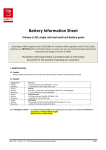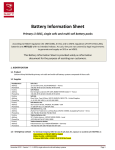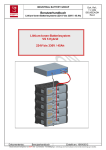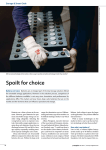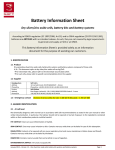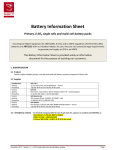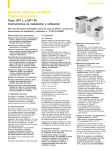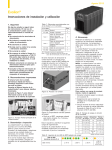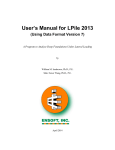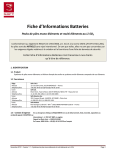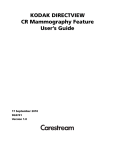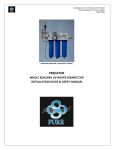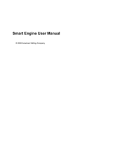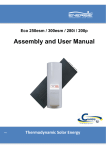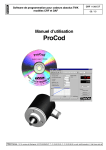Download Intensium Home 48 Volt 4Kwh Li ion Installation And
Transcript
September 2013 Intensium® Home 48 V/4 kWh Installation and operating instructions 1. System description and main specifications The energy storage system Intensium® Home is based on the series connection of 2 Synerion® 24M modules and the Battery Management Module (BMM) that monitors and protects all modules from extreme situations (overcharge, over-discharge and over-temperature). The main characteristics can be found in table below. For more information on the technical specifications, refer to the product datasheet. Table 1: Intensium® Home main specifications Nominal Voltage (V) 48 Minimum Voltage (V) 42 Maximum Voltage (V) 56 that non authorized persons, especially children, do not access the battery whatever the conditions are. The non-respect of the safety rules described in this document may expose persons and equipment to risks of accident. General safety rules for the use of Saft Li-ion batteries Saft products are designed with full consideration of safety. However, batteries can be dangerous if used inappropriately. The violation of safety rules described below by installers or users may cause the battery system to overheat or ignite causing serious injuries. ■■ Never short-circuit the battery terminals Rated Capacity (kWh) 4 ■■ Do not reverse the polarity Maximum current (A) 160 ■■ Maximum discharge power (kW)* 7.6 Do not overcharge or overdischarge Maximum charge power (kW)* 4.1 ■■ Weight (kg) 85 Do not open the cabinet, battery modules and BMM Width (mm) 535 ■■ Do not use the unit without its BMM Depth (mm) 520 ■■ Height (mm) 700 Do not subject to excessive mechanical stress ■■ Do not expose the unit to water or condensation. *The maximum power could be limited by the inverter 2. Safety A battery system is an active electrical device that contains an important quantity of energy and must respect certain safety rules like other electrical devices and storage systems (i.e. a fuel tank). WARNING: All persons in potential contact with the battery system must understand and respect the safety rules described below. If the battery system is not installed in a closed room only accessible to authorized persons but in a residential environment, it is particularly important that all living persons understand and respect the safety rules below during the entire operating period of the battery. It is the responsibility of the user to assure Safety rules concerning access: ■■ The battery must always be used in its cabinet. ■■ The cabinet is delivered with a key to lock the door. This key is kept by the installer. ■■ The access to the battery interior is reserved to Saft and Saft authorized installers. ■■ The access to the switch and interface buttons inside the cabinet is reserved to users aware of risks associated to batteries and electrical devices under voltage. ■■ Any intervention done by installer must be done with insulated tools and with the adequate protections (60 V) for the manipulation of devices under voltage. Safety rules concerning installation: ■■ The storage system must be installed in non-living area. ■■ The installation should be compliant to the local regulations applicable for building and electrical installations, such as fire protection, seismic, flooding... ■■ The installation room must have a door or window allowing quick air exchange with the outdoor in case of accident. A minimum air flow of 125 m3/h should be guaranteed. In case such air flow cannot be guaranteed, contact Saft to study an alternative solution for ventilation. ■■ It is recommended to install the battery in a room with at least 8 m3. ■■ It is mandatory to install a CO or fumes detector above the battery system, activating a local visual/audible alarm in order to alert the end user. ■■ The floors and walls within 1 m distance of the battery system shall not be flammable in order to avoid fire propagation in case of accident. ■■ Do not place flammable products such as oil, diesel, alcohol etc. close to the battery system. A minimum distance of 1 m must be kept. ■■ Do not place objects in the top of the cabinet. ■■ The free gap between the cabinet and the walls (including the roof) must be superior to 25 cm. If 2 or more systems are installed in the same room, take into account 10 cm of gap between each cabinet if side by side and 20 cm of gap between each cabinet if back to back. •1 19” cabinet pre-equipped of: ■■ The installation room should be compatible with pollution level 2 according to EN 60664-1 standard. •Cables between breaker and customer (2 m long) ■■ Do not place the batteries near fires or other high-temperature locations (> 70°C). Doing so may cause the batteries to overheat or ignite. Using the batteries in this manner may also result in a loss of performance and a shortened life expectancy. ■■ 3. Important recommendations in case of abnormal events (gas release, fire etc.) ■■ ■■ ■■ • Disconnect switch • RJ45 plugs and caps • Cable glands •Legs Power cables of 50 mm2 (2 m long) Color code: black for negative and red for positive RJ 45 connectors with caps Breaker Battery Management Module (BMM) In case of battery failure with gas emissions, it is important to proceed as soon as possible to open the door or window and evacuate any present people and animals. Wait at least 20 minutes to enter the room again (for rooms between 8 m3 and 24 m3). If such air exchange is impossible after detection of fumes, it will take 2 h for a 16 m3 room and 3 h for a 24 m3 room to dilute the concentration of gases to a safe level (considering a typical air circulation flow of 15 m3/h). Contact Saft for further information in case of rooms with different volume. 4. General description The Intensium® Home storage system is composed of: •2 Li-ion modules Synerion® 24M •1 Battery Management Module (BMM) Battery is shipped with a state of charge of 50% ensuring at least 5 months of storage between 20°C and 40°C. IMPORTANT: For lithium-ion technology, when the cell voltage reaches a very low value, the battery may be no longer operational. In case of alarm or warning related to under-voltage, contact Saft in a maximum time of 14 days in order to avoid damaging the battery. 6. Installation The installation of the Intensium® Home system must be done by an installer with the local electrical certifications and trained by Saft. Read the Battery Information Sheet delivered with the battery and available at www.saftbatteries.com for main emergency response procedures with Li-ion batteries. Immediately disconnect the battery system if, during operation, unusual smell, heat, deformations or other anomalies are detected. Contact Saft if any of these abnormal situations are observed. To disconnect the battery open the disconnect switch (top of cabinet). Example: If the user estimates a storage time of 3 months without any use, it is recommended to stop the system when the SOC indication has 3 LEDS on (SOC > 40%). Communication wires Synerion® 24M modules Figure 1: General drawing of Intensium® Home with interfaces 5. Extended storage periods (longer than 1 month) of Intensium® Home It is recommended to store the battery indoors in a dry and cool location (lower than 40°C) on open shelves in order to preserve battery lifetime. Extended storage duration of Intensium® Home in OFF mode, especially in case of low SOC, can lead to a deep discharge of the battery system because of self-discharge. Depending on the storage time anticipated by the user, it is recommended to ensure a minimum SOC level before stopping the system. Maximum storage time depending on SOC is given in table below. The installer will mount the system previously delivered in kits (one package for modules, one for BMM, one for cabinet and one accessory kit with cables). The end user of the system will not have access to the inside part of the cabinet. The end user will only be able to access the switch and the HMI with LED indicators via two openings located in the door. 7. Operation The Intensium® Home storage system operates in an automatic manner according to the orders to charge or discharge received by the inverter connected to it. The BMM is able to monitor and manage the battery in safe conditions with respect to physical parameters such as cell voltages, battery current and module temperature. The acceptable ranges of temperature, current and voltage of the system can be found in the datasheet. Table 2: Maximum storage time as a function of SOC 10% > 20% > 40% > 60% Months @ 20°C 1 3 5.5 8.5 Months @ 40°C 1 2 4 6 SOC Indication SOC The end user mainly needs to understand the HMI and switch located on the BMM that are accessible from the outside of the cabinet (see figure below). HMI (button and 4 LEDs) Switch 3 positions OFF/ON/START Figure 2: View of BMM front side with accessible parts in red In the top opening, there are 4 LEDs and one push button allowing the selection of the LED indication. There are 3 different indications: •Battery status •State Of Charge (SOC) •State Of Health (SOH) Push button not activated: Battery status Orange-Steady Minor alarm (warning) Red-Steady Major alarm Green-Fast blinking (0.1s) Green – Slow blinking lent (0.6s) Green-Steady Charge Floating Discharge Push button activated less than 3 seconds: SOC Steady SOC > 60% Steady SOC > 40% Steady SOC > 20% Steady SOC ≤ 20% Push button activated more than 3 seconds: SOH Blinking SOH > 75% Blinking SOH > 50% Blinking SOH > 25% Blinking SOH ≤ 25% NOTE: The SOH indicates 100% at beginning of life and 0% at end of life. The end of life is defined for a capacity loss of 30% with respect to initial capacity. Start and stop of Intensium® Home To start the battery system it is necessary to put the switch in ON position and push the switch during 1 second. The BMM will automatically perform the start tests and ask the inverter the authorization to close the contactor, which is necessary condition to allow charging or discharging the battery. If the start tests fail, the battery will change to SAFE mode and cannot be used. Contact Saft to reset the system in order to be able to use the battery system. 9. Removal and recycling 1. Shut-down the Intensium® Home by opening the disconnect switch and pushing the OFF button of BMM 2. Disconnect the power terminals. 3. Disconnect alarm/ communication cables. 4. Remove the Intensium® Home and stage for recycling. 5. Call your installer or local Saft representative for further assistance. 10. Use with different inverters To stop the system it is necessary to put the switch in OFF position. The battery will be fully shut down in a maximum time of 5 seconds. For the installation, please follow the guidelines for electrical connection with batteries provided by the inverter manufacturers. IMPORTANT: The switch should be in OFF position if the battery system is not used for several days in order to avoid deep-discharge of Intensium® Home because of electronics consumption (i.e. SOC is reduced by 6% per day if BMM is ON and the battery is not used.) For the operation, please refer to the user manual of inverters for an adequate operation of the complete system. Note that several versions of Intensium® Home are available depending on the communication protocol (CAN) and the precharge management compatible with different inverters. The part numbers of the different versions are given in Table 3. Each version can be configured at a different communication speed and contactor management strategy. Please double-check with Saft these two points before Intensium® Home delivery. 8. Transport and packaging The lithium-ion batteries are restricted for transport according to UN Recommendations of Dangerous Goods (UN 3480). The battery system must be transported in a packaging compliant with the UN recommendations of dangerous goods, the appropriate applicable regulations such as IATA (Air), IMDG Code (Maritime), ADR (Road in Europe) and any other local regulations required. The package must display a class 9 hazard label in addition to markings identifying the applicable proper shipping name (Lithium ion batteries) and UN number (3480). When packing, avoid any risk of short-circuit between terminals. For that purpose, the use of plastic bags is recommended. Make sure that the packaged components are internally blocked to avoid moves during transportation. NOTE: It is advised to save the original packaging for reuse in case of later shipment. Table 3: Precharge CANopen CAN 2.0 A CAN 2.0 B (seconds) Asynchronous 5 774231-00 10 774231-01 12 774232-00 774230-00 Saft Industrial Battery Group 12, rue Sadi Carnot 93170 Bagnolet - France Tel :+33 (0)1 49 93 19 18 Fax:+33 (0)1 49 93 19 64 Doc. Nº 21877-2-0913 Edition: September 2013 Data in this document is subject to change without notice and becomes contractual only after written confirmation. Société par Actions Simplifiée au capital de 31 944 000 € RCS Bobigny B 383 703 873 www.saftbatteries.com Produced in the UK by Arthur Associates Limited




